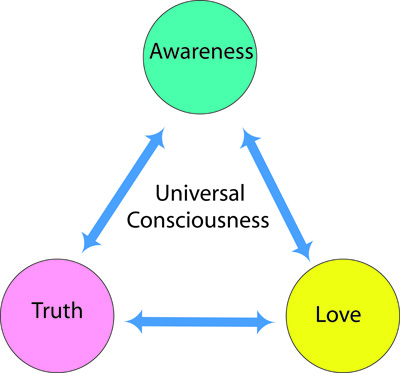Why new?
A darshan is a “vision of the divine”. It is a fundamental step in the development of a complete ontology, the foundation of a “world view” that provides an understanding of the physical and spiritual (transcendent) aspects of human life.
For adherents of scriptural based religions, their “world view” is derived from the authors and interpreters of the sacred texts and their darshan is basically their faith that the sacred texts are the “word of God (or Brahma)”.
For those who cling to the “world view” of material realism, there is no place for darshan because of their faith that transcendence does not exist.
Throughout history there have been spiritual movements based on a darshan that is not scriptural based. Prominent among these is Buddhism. In the classical world these darshans were compatible with a “world view” that assumed that the physical Cosmos was static: infinite and eternal. Therefore, in an Old Darshan the “vision of the transcendent” had no need to include the concept of creation or a Creator. The Old Darshan has provided important spiritual insight and guidance to countless people over many centuries.
But now we know from scientific observation that our Cosmos had a beginning: it is not eternal and it is not static – it is, in fact, expanding at an accelerating pace. The purpose of this blog is to describe a New Darshan that is compatible with the observations of modern science and incorporates valuable understanding of the transcendent that the Old Darshan has provided. The spiritual aspect of the New Darshan is its focus on Oneness and the attempt to avoid the dualism that has plagued so much of the world’s religious, social and political history.
What’s new?
The scientific roots of the New Darshan emerge from recent studies using Quantum Theory of the smallest objects in spacetime, and studies in Cosmology of the origin and nature of the entire universe (spacetime itself).
– Quantum entanglement:
Experiments in quantum entanglement made over the last 30 years or so have proven beyond a doubt that entangled quantum states exist in a nonlocal reality. “Nonlocal” means that entanglements exist outside of our “local” 3D+1 reality. In our “local” reality effects follow causes by a finite amount of time because information cannot be transmitted in 3D+1 faster than the speed of light. (The description of our local spacetime as “3D+1” is based on its structure of 3 observable space dimensions plus one dimension of time.) The nature of the nonlocal reality where quantum states are entangled and causality does not apply is not subject to direct observation using local instruments. But the existence of nonlocal quantum entanglement is an established observational fact. The existence of a nonlocal reality is often described as a quantum paradox.
– Wave/particle duality:
The origins of quantum mechanics go back more than a century. It has proven to be one of the most successful scientific enterprises of all time. Its equations have been used to predict observations of quantum phenomena with incredible accuracy (e.g., to 10 decimal places in the case of some experiments in quantum electrodynamics.) But paradoxes have been part of the theory from the very beginning.
The first was the wave/particle duality of matter and light. Neils Bohr resolved this paradox to his satisfaction, with what is now known as the Copenhagen interpretation of quantum mechanics, through the advancement of the idea of Complimentarity. This said that either the wave or particle nature would be revealed by the type of quantum observation chosen by the observer, but not both. In this interpretation, the key element to resolving the paradox is “choice”.
Perhaps the most paradoxical of the wave/particle duality experiments is the famous Young’s double slit experiment. In this experiment an opaque screen, in which two slits have been cut, is positioned between a source and a detector of light. Modern versions of this experiment have passed single photons or material particles like electrons through a double slit arrangement and provided for detection of single particles on the downstream side of the slits.
After passing many single particles through the apparatus, an interference pattern is observed showing that, at the position of the slits, the single particle was actually at two places at once. That is, though beginning and ending its journey through the apparatus as a point particle, it behaved as a wave at the position of the slits. (For more on this, please see .)
If the observer chooses to determine which slit the particle actually passes through, the wave nature of the particle is not manifested: the interference pattern is destroyed. Here, again, “choice” is the key element in resolving the paradox.
The most recent form of these experiments, known as “delayed choice” experiments, have demonstrated that the timing of the choice (whether to determine the actual “slit” or not) does not affect the outcome of the experiment. This is true even if the choice is made nonlocally: that is, in situations where, in order for the choice to effect the particle at the beginning of its journey would require faster than light communication. In other words, in these experiments, the choice to determine or not the actual path will effect the outcome even if the choice is made after the particle is already inside the apparatus.
So, here again, as in the entanglement experiments, quantum behavior is explainable only by the existence of a nonlocal reality and is observed to be determined by nonlocal choices. This, again, is described as a quantum paradox. (See for example http://www.pnas.org/content/110/4/1221 .)
– General relativity.
For the last 50 years, or so, observational Cosmology has focused on the reality and consequences of the Big Bang: a unique event that lies at the very beginning of our expanding 3D+1 spacetime. The time with which we measure change in our Cosmos began in the Big Bang (t=0).
There is no scientific way to observe what went “before” the Big Bang or what exists outside of spacetime. But Einstein’s theory of General Relativity, which has had great success at explaining the observations of modern Cosmology, is based on the idea that the Big Bang emerged from the nonlocal reality of a Singularity. Being outside of spacetime, the Singularity is unobservable and is a subject for metaphysics and mathematical imagination, but not empirical science.
Another aspect of General Relativity is the discovery of what is called the “fine tuning” of the physical Cosmos. The initial conditions of the Big Bang and the physical constants that determine the dynamics of the expansion of the Cosmos had to be “fine tuned” with incredibly improbable values in order for stable matter to exist and for the Cosmos to persist for the last 13.8 billion years.
It’s not possible for me to put an accurate value to the total improbability of my existence, but just the fine tuning of the initial energy densities in the Cosmos that allows the persistence of the Cosmos alone is of the order of 10-60 . And the symmetry-breaking that allowed there to be an excess of matter over anti-matter in the early universe has a probability of the order of 10-9. Then there is the exact balance among the fundamental forces and particle masses that permits stable atoms to exist and then the quantum tunneling processes that permits stars to burn and explode providing the chemical elements that make up the rocky planets. (Recent measurements with the Keppler space telescope indicate that there are probably about 1022 such planets in the Cosmos.) And then there is the improbability of the emergence of self-aware beings on our planet along with little details essential to human life like the fact that solid water is lighter than liquid water. I can’t be sure, but I guess the probability that I am sitting here writing this has got be less than something like 10-100. This is a pretty fair definition of a scientific miracle.
There is no scientific explanation for this miracle. There is only metaphysics and mathematical imagination. Many scientists of the material realist persuasion see the miracle as just a highly improbable accident: a random event among an infinity (or very large number, like 10500) of Big Bangs creating other (3D+1?) universes.
New metaphysics.
The metaphysics of the New Darshan includes the hypothesis that the nonlocal reality of Quantum Mechanics is consciousness itself. It is choice that collapses all quantum wave-functions and resolves all quantum paradoxes. And the essence of consciousness is choice.
This hypothesis is not new with me. I suspect there are many scientists and thinkers who have come to the same conclusion. The great physicist, John Archibald Wheeler, who wrote the book on General Relativity and proposed things like black holes, worm holes, and the “delayed choice” experiments of quantum theory, looked deeply into the quantum nature of things and introduced into physics more than 30 years ago, the phrase “It from bit”. Wheeler is implying that the most elementary aspect of nature is information (not matter/energy). And the process of creating reality and doing science is the process of creating “its” from “bits”. A “bit” is a yes/no question and the process of creating an “it” is a choice – an act of consciousness. This is what Wheeler meant by his characterization of our Cosmos as a “participatory universe.”
This metaphysical hypothesis was explored at great lengths by the quantum physicist, Amit Goswami, Ph.D., in his book The Self-Aware Universe (Jeremy P. Tarcher/Putnam, N.Y., 1995). Goswami proposed that consciousness is the ground of all being and defined the essence of life with the Cartesian phrase “Opto ergo sum” – “I choose therefore I am“. The subtitle of Goswami’s book is “how consciousness creates the material world”.
I propose to extend the New Darshan with the hypothesis. that the first “it” in our Cosmos was the first Planck bubble (a quantum region of unified forces, complete uncertainty, where only probabilities exist, about 10-35 m in diameter) This first “it” emerged from the Singularity and began the Big Bang.
The metaphysical principle of “as below, so above”, would imply that this process of the creation of the first “it” of reality was also a conscious choice. This would imply the startling metaphysical hypothesis that the Singularity is alive and is the source of all consciousness and life in the Cosmos.
My hopes for future postings on this blog.
In the blog posts that will follow describing the New Darshan, I will explore the scientific implications of the possibility that the Singularity of the Big Bang and the nonlocal reality of Quantum Mechanics are one and the same. I will attempt to identify teleological aspects of evolution that support the hypothesis that the universe began with a conscious choice. I will explore the spiritual aspect of the New Darshan in terms of the dynamics of consciousness and creation. These dynamics are intimately related to the unitary process of co-inherence. I will address the morality that flows from the New Darshan as emphasizing the equality of all self-aware beings and the value of cooperation in the development of global human society.
(Some of the intellectual ideas of the New Darshan have been expressed in the language of my heart as it opens to the inevitability of death in my recent poem, In Time. )

